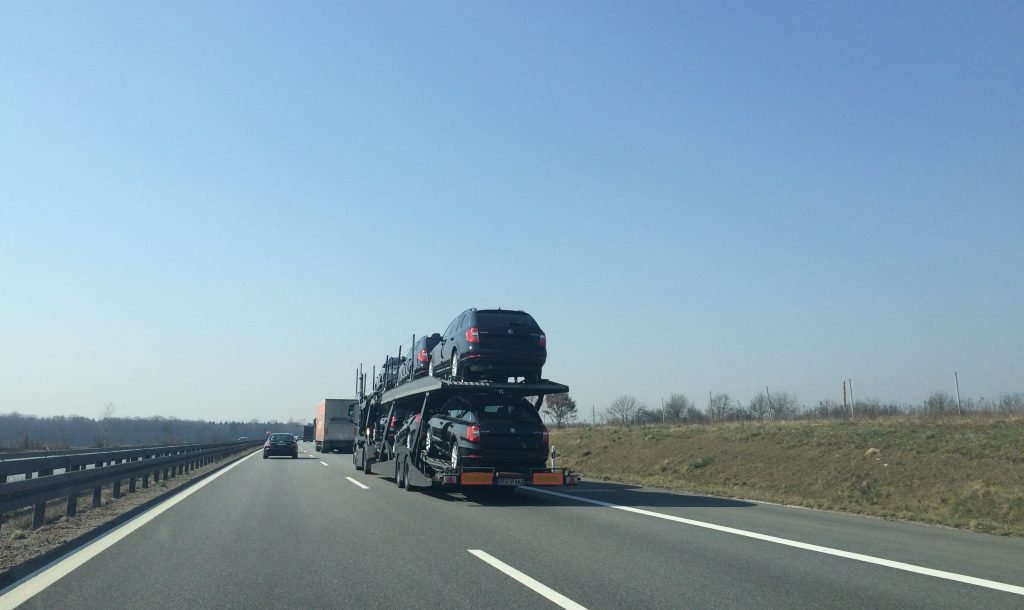And this growth requires us to know a little more about the process and peculiarities that come with it. We reveal some facts that we have found to be interesting. Some might be surprising, others might be scary. All of them, however, quite important to know ahead. Buckle up! Let’s explore the 7 facts about auto transport.
Shipping new cars
Every time an auto manufacturer sends out a new car to a dealership, it does so via a carrier truck. It may seem a paradox that cars, which are made to be driven, have to be carried. Yet, nobody would want to buy “a brand new car” with 3,000 miles on. It is not new anymore. What is more interesting is that transportation costs quite a lot to automakers.
The cost of shipping a new vehicle to a dealership is called a destination charge. As you can imagine, the customers pay it as part of the vehicle’s price.
This occurs in the form of a tax which does not depend on the type of vehicle. Usually, automakers receive a nationwide average for this cost. This can only mean that, even if an SUV costs more than a small compact car, the tax for both of them remains the same whether the vehicle travels one mile or 1,500 miles from the factory.

One special case is the delivery of new race cars. It is completely forbidden to transport race cars by driving them.
The main reason for this is the damage the road and weather would cause to vehicles. Most of the time, race car teams have their own trailers with branded names and logos.
These specially designed vehicles are custom-built aluminum trailers with two enclosed decks and they are usually used by Indycar and NASCAR teams. The shipping of NASCAR cars has turned into a special service uniting the people behind the NASCAR haulers in a culture of devotion to these vehicles.
After all, it requires extra effort to make sure the race car arrives in time for the race. Nobody wants a race without the racing cars, right?
Transport time is always an estimate
Car shipping is usually a service requested for long distances. And in these cases, shipping companies cannot predict all possible situations that may occur on the road – traffic, weather conditions, and possible mechanical failures.
Forecasts help us get a relative time frame, but the specifics of the road remain unknown. When you ship a car, let’s say, from Chicago to Los Angeles, you have to pass through Colorado. And driving through the Colorado Mountains is hard: it means lower gears and slower speed. During winter the carrier could face dangerous storms and slippery roads.
Unfortunately, shipping delays may occur because of a truck failure as well. Even though trucks are utilized daily and undergo regular check-ups, malfunctions occur. Trucks do not break down every day but companies need to have this in mind in order to avoid customer dissatisfaction.
Insurance during transport
Legally, all auto transporters are required to have liability insurance. And the type of vehicle you are shipping determines the amount of coverage you need. Virtually all companies will tell you that your car is insured – however, coverage may vary, and your car may not be protected.
When you start researching the shipping companies, inquire about insurance coverage. If you can’t find an answer, this could be a sign that the company is not legally authorized to operate. To avoid any unpleasant surprises, make sure your transporter offers cargo insurance.
If you are shipping a classic vehicle, make sure the insurance is about that type of vehicle. If you are transporting a sports or luxury car, request insurance coverage for this specifically.

Typically, auto transporters purchase $250,000 coverage, which comes down to about $25,000 per car. When shipping a car that is worth more we recommend that you request a carrier with greater coverage.
All open car carriers usually have a liability of $250,000. Many enclosed trailers carry insurance of $500,000, and that can go up to $2 million if the customers prefer. This coverage includes damages during loading, unloading, and transit. It also includes anything from theft, dents, and scratches to a total loss of a vehicle.
Freight hijacking is real
According to a joint report by BSI Supply Chain Services and Solutions and transport and logistics insurer TT Club, hijackings make up nearly a quarter of cargo theft incidents around the world. With national economies going global, this probably shouldn’t surprise us. And still, it does. What is even more frustrating is the fact that trucks are the most vulnerable types of cargo carriers.
In such cases, the cargo is more important to the hijackers than the truck itself. This is why we recommend shipping high-cost vehicles in enclosed carriers. Enclosed auto transport does not only protect cars from damage, but it also decreases the visibility of the cars from other people on the road. This way it is less likely that your Lamborghini will get someone’s eyes on it.
In order to cope with the increasing rates of freight hijacking, trucking and shipping companies are investing more in security systems and better planning techniques.
According to the report, thieves in the United States and Canada most frequently steal unattended cargo trucks parked at unsecured locations, including truck stops and gas stations. Hijackings in these two countries are extremely rare, the report states.
Strict requirements for truck drivers
Many people think that driving a truck is an easy job. And the only reason people become drivers is the lack of talent. In fact, it is quite the opposite. The job of a trucker is demanding, which is why the requirements for drivers are so strict. This is one of the reasons the industry is now facing a shortage of drivers.
Physical fitness
Driving requires multitasking, which requires alertness. To be alert one needs to be in good physical condition. The Federal Motor Carrier Safety Administration requires all drivers to pass a DOT medical exam before earning a commercial driver’s license. During the physical examination, your doctor checks your overall health and each body system, marking it as normal or abnormal. Including tests on your urine, blood pressure, eyes, and hearing. At the end of the exam, you receive one of three answers – you are clear to drive for two years, you may be allowed to drive but with periodic follow-ups, or you may be denied the right to drive a truck because you don’t meet the health standards.
Psychological stability
From then on, candidates pass psychological tests which check their mental suitability for the job. Truck drivers need to be patient and flexible. They may be on the road for ten hours in a day, numerous days in a row. They might not see their family for months. This requires mental strength and adaptability. Moreover, unlike typical office jobs, there will be no people around them at all. Drivers need to be comfortable with being alone and not let solitude get to their heads.
Mechanical knowledge
Last but not least – the knowledge of mechanics. Truck drivers should have a basic understanding of the truck’s engine and mechanics, so they can fix minor problems like changing a light bulb. Most of the time there is no manager or supervisor to ask for advice right on the sport if a failure occurs. They have to be self-dependent and find a solution on their own. The more a truck driver knows about mechanics the better for him and his packet in fact.
These might seem like regular requirements, but these are only the essentials. It is funny when you think about the fact that a huge part of the economy depends on people with such characteristics. And that has turned into a problem. According to different sources, the industry currently lacks between 50-90,000 drivers. According to the American Trucking Associations, however, The US will be short 175,000 truck drivers by 2026. And this lack of drivers is already delaying orders and making goods more expensive as freight rates climb.
Trucking is now digital
Yes, and this is not only because of the implementation of the ELD mandate. Whether we like it or not, ELDs will become part of the trucking world. But apart from that, there is plenty of tech talk going on in the industry.
Do we need to remind you of the Tesla semi-truck that was spotted on Californian highways earlier this year? And it’s not only Tesla – Waymo and Volvo are following the same steps. Manufacturers consider autonomous trucking to help the industry reach its full potential. Yet, we are still far away from fully adopting them, primarily because of legal issues. Until then, there are other little perks that can disrupt the industry.
There are various mobile apps targeted at trucking companies, whose focus is on-demand freight. Uber Freight is one of these apps. You shouldn’t be surprised that Uber is among the pioneers in these solutions. The company has disrupted numerous aspects of the automobile industry and is naturally spreading to trucking. Despite the fact that the company will no longer invest in self-driving trucks, Uber remains in the industry through its technologies. The app operates by matching truck companies with shippers who need to get something moved.
Experts say that if trucking companies adopt technological solutions in their operations, there is a good chance they won’t have to deal with the driver shortage.
Low regulation leads to high interpretation
An interesting fact about the auto transport industry is that there is not much regulation on how to actually sell the service. There are certain requirements regarding specific steps in the process, yet there isn’t a holistic approach to providing the service. This leaves space for companies who don’t have your best interest at heart to operate and survive off people’s backs.
Many big companies don’t practice unethical behavior. Yet, some businesses tolerate it in order to get to the sales targets they have set for the period. Learn to recognize the intentions behind the behavior. When you talk to someone on the phone, watch out for the things they ask you, their interest in you, and their devotion to your specific situation.
Many times there could be one arrogant salesperson who will forget you exist the moment they book you and get your deposit. Insist on follow-up communication and frequent updates on when they are coming, who will call you, and how you should proceed.
The DOT has regulations regarding safety and insurance, but as far as regulation for how the service is sold – it is pretty much left in the air. Basic consumer protection laws are all that protect you so there are no specific requirements bad transport companies have to be accountable for.
This is why reviews are very important – when you have a bad experience with a company, make sure you spread the word so that others know to avoid them. When you feel like you received white-glove service, make that visible to others, too. This will encourage companies with good customer service to become great, and bad ones will drop out of the market.



